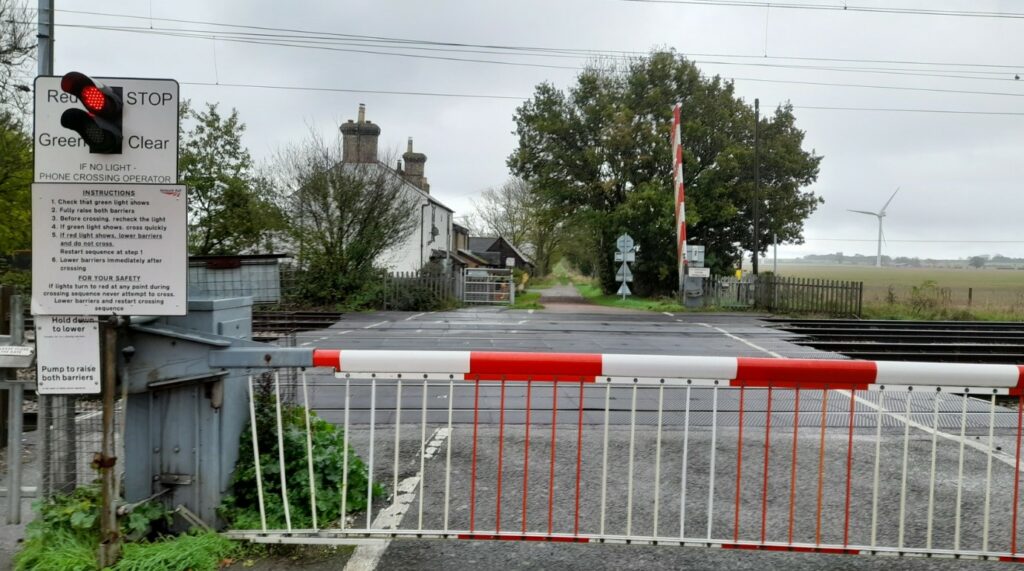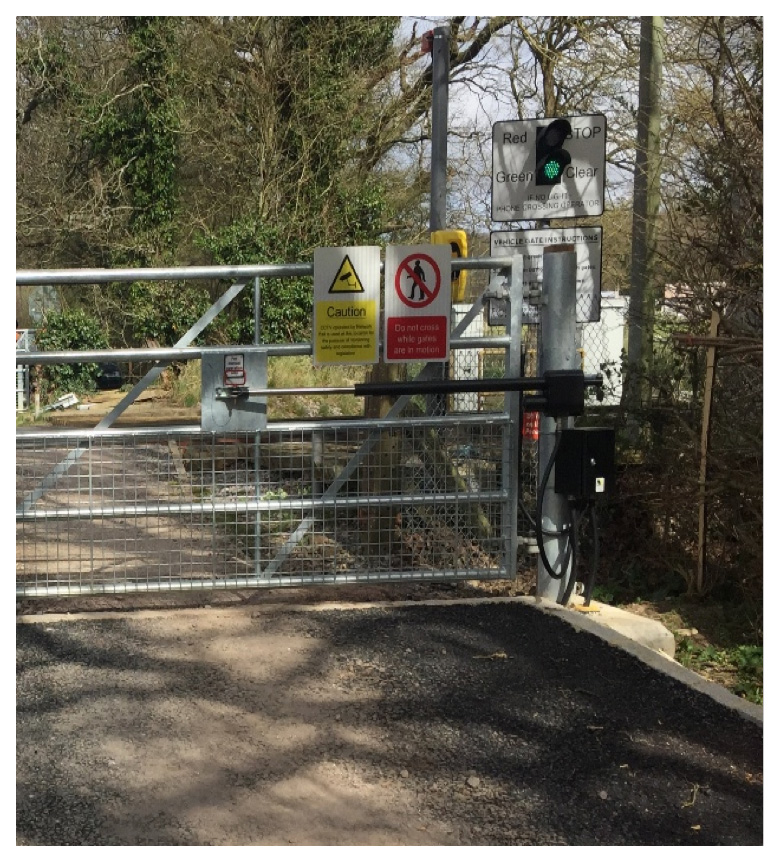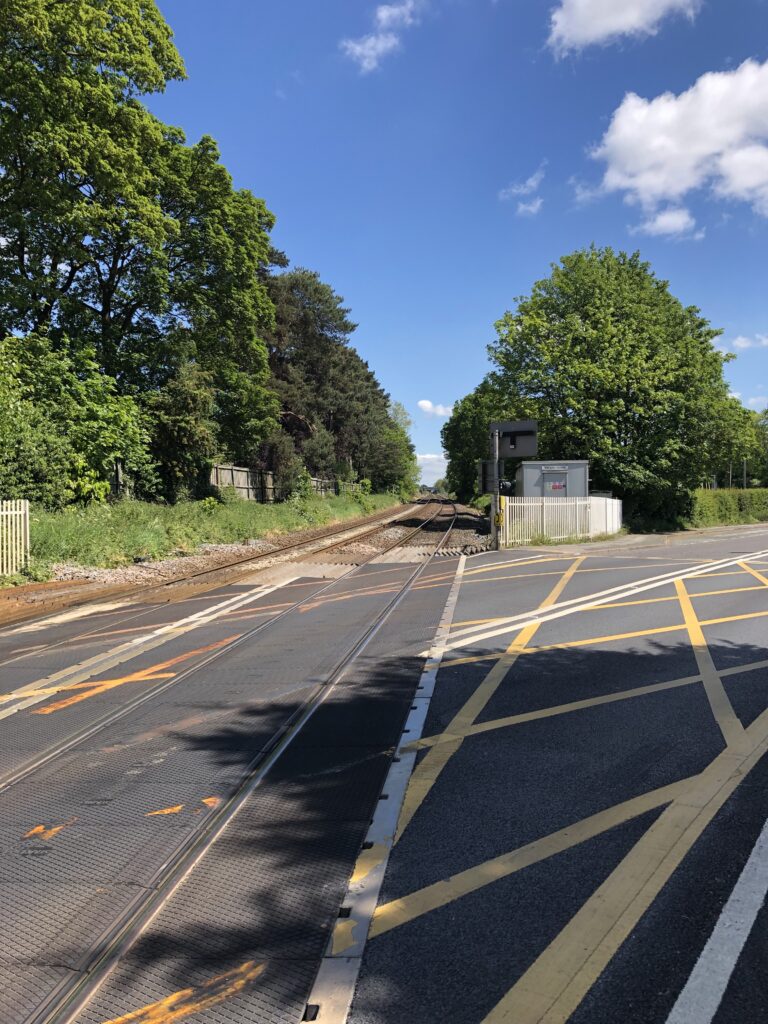Jonathan Evans, Network Rail’s technical head of level crossings engineering, recently delivered a presentation to the IRSE Midland & North Western Section, explaining how technology can help to improve level crossing risk management, together with the level crossing engineering solutions being developed by Network Rail. Jonathan explained that his team are part of the technical authority at Network Rail responsible for engineering approval. Colleagues across the wider part of Network Rail, including the level crossing safety teams, Route Services, and partners within the supply chain, also have a vital role in managing level crossing risk explained Jonathan.
Whistle boards
The ‘passive’ 70% of all level crossings on the network require a user to stop, look, and listen in order to determine whether or not it’s safe to cross. Whistle boards are provided at many crossings where there is insufficient siting distance, so that as a train approaches it sounds its horn and provides the crossing user with an audible warning to mitigate the lack of visibility. However, it can be difficult to hear a distant train horn, particularly in noisy environments, and train horns are not sounded at night during the nighttime ‘quiet period’ – between midnight and 06:00. Because of this issue, the long-term goal is to eliminate whistle boards for level crossing purposes.
An incremental improvement is to provide a supplementary audible warning system, which detects an approaching train and provides an audible warning at the crossing. The Covtec system uses a radar to detect a train and a wireless comms link between a remote detection unit and the crossing sounder. The system uses ‘off grid’ solar power and is independent of the signalling system. It detects trains and sounds a recording of a train horn at the crossing. The system currently has no specific safety integrity and users are not provided with any visual indication of whether it’s safe to cross or not. Therefore, whistle boards currently have to be retained to guard against system failure and, of course, a sound warning does not assist users with hearing issues.
Overlay Miniature Stop Light systems

For many years, footpath and bridleway private crossings have been provided with an audible, visual, active warning solution using ‘miniature’, stoplights. These are called Miniature Stop Light (MSL) crossings. There are different types of MSL system:
- Integrated MSL. These were the original design of MSL and are built into the railway signalling system, which makes them costly and complex to install. However, as they form part of the signalling system, they are suitable for any location, including those where signals and stations lie between crossings and their ‘strike in’ points. A level crossing strike in point is the distance from a level crossing where a train initiates the closure sequence of the crossing. If a train is held at a signal or station, controls are applied to prevent the red light from showing at the crossing until the train is about to start moving again, avoiding excessive warning times.
- Overlay MSL (OMSL). These are separate from the railway signalling system. They can be installed at locations where the railway does not have complex features, such as nearby stop signals. These MSLs use a basic train detection system which detects trains a set distance from the crossing.
- Flex MSL. These use the same technology as OMSL systems but can receive inputs from a signal on each approach to a crossing. This allows them to be installed at locations where trains may be regularly stopped by a signal within the strike in area.
If the time between strike in and the train arriving at the crossing is longer than designed, it can result in red lights being displayed for prolonged periods and/or the OMSL system going into what is known as ‘dark mode’, where the lights at the crossing are turned off until the passage of another train resets the OMSL. Frequent long warning times or occurrences of dark mode are unacceptable as they diminish level crossing users’ faith in, and compliance with, the red and green lights at the crossing. So OMSLs are not suitable where there are signals which could regularly delay a train’s arrival at the crossing.
However, one of the advantages of the OMSL is to allow for innovation in the form of the type of train detection, such as acoustic detection. There are now around 250 OMSL solutions in use across the network and they’ve made a significant improvement to safety. Further systems are regularly being installed.
The basic principle of the Wavetrain acoustic detection system is that sensors are attached to the rail located at the level crossing, which detect sound waves generated by an approaching train passing through the rails. Locating all of the equipment at the level crossing avoids the need to run cables to remote ‘strike in’ train detection equipment. The system also provides the potential to deliver more consistent warning times, irrespective of the speed of approaching trains. Although with modern, faster-accelerating trains this is not easy.
More traditional systems, which rely on fixed point train detection for ‘strike in’, have to be positioned for the maximum speed, and consequently they can give extended warning times for slower trains. Research has shown that extended warning times can affect the willingness of crossing users to wait.
A single-track version of Wavetrain OMSL is currently on shadow trial in East Midlands, and Network Rail hopes to progress this into an operational trial later this year. A shadow trial is one where the system is essentially fully functional in detecting trains but provides no warnings to crossing users to avoid any issues with it being incorrect while on test.
Originally, the lights for MSLs (as the name suggests) were quite small. They were based on automotive parts with a lens not less than 60mm diameter. Nowadays, MSLs for level crossings use a far larger 200mm diameter and comply with the British Standard for road traffic light signals. They also present a much more visible interface to the user. Network Rail has also developed an interface box to enable the larger units to be retrofitted to older MSL systems to improve their visibility.
Currently, OMSL systems are only suitable for locations with simple approaches, usually without signals, junctions, or stations within their striking distance. As more OMSLs are rolled out, attention is turning to innovations that will allow the provision of OMSLs at more complex locations.

This does present challenges, but MSL’s interfaced with the signalling system are on trial at several locations. An interface with the signalling system avoids a prolonged warning which can lead to impatience or misuse. It may also be possible to develop a solution based on measuring the speed of an approaching train and initiate the necessary warning at the optimum time.
Power Operated Gate Open
Care is needed when developing level crossing technical solutions to ensure that level crossing safety is improved and not degraded. An example is the Power Operated Gate Open (POGO). This was developed around 15 years ago, as a way of improving the safety and convenience for crossing users by providing buttons on both sides of a crossing to open and close the gates, and to reduce the number of times to cross the railway. Normally, a gated user-worked crossing would need to be traversed five times when crossing with a vehicle. There was also a risk of the gates being left open.
The POGO appeared to be a good idea, but unfortunately the early implementations resulted in some near misses. The user expectation was that if the gate opened after a button was operated, then it must be safe to cross. Whereas, in practice, the POGO system had no knowledge of whether trains were approaching or not, as the user was still required to decide whether or not it was safe to cross.
POGOs were removed from use, but there have been a number of developments. POGOs are now used in conjunction with an MSL system with a link between the two systems, such that once the MSL has gone to red, the POGO system will not respond to a request to open the gates. The signage has also been improved; the operating buttons have been made more prominent, together with a yellow surround. It was found that some animals were capable of opening the gates with their tongues!
Power supplies
Many level crossings on the GB railway are located in remote locations with no convenient power supply and an active level crossing will need a power supply. Even an IP telephone will need a power supply. Network Rail is therefore developing renewable power solutions using off grid power sources, such as solar and small wind turbines, together with methanol fuel cells to provide continuity of supply when the weather doesn’t supply sufficient power. Several systems are currently on trial.
Public crossing innovations
Network Rail is also continuing to improve public road level crossings. There have been a small number of incidents over the years, where the visibility of the barriers has been called into question, resulting in a need for improved barrier boom lighting. New barrier boom lighting is therefore being introduced with the output of the lamps between 30 and 50 candelas, which is about 15 times brighter than the existing lamps, and the size is also being increased to double that of the original.
Another development, aimed at deterring weaving around half barrier crossings by road vehicle drivers, is the use of a retrofit barrier boom extension. The red retro reflective extension narrows the exit width by around half a metre and makes the boom more prominent. It is made from lightweight plastic which doesn’t significantly change the balance of the boom, and if someone felt they were trapped on the crossing they could push the extension out of the way.
The prototype extension has been trialled in some non-operational environments and has received positive stakeholder feedback. Six level crossings at a mix of place types have been identified on the network which will provide experience in a range of different contexts, from straight, fast roads to busy urban settings.

Obstacle detector operated level crossings have been a big success and Network Rail has been working with a new supplier, IDS of Italy, to develop a second generation of obstacle detection systems.
To improve availability and simplify the interface with the level crossing controller, the new system involves just three inputs and three outputs, and overcomes some component obsolescence issues with the first generation system. The new system uses a single radar to provide both the train protection and people protection functions, dispensing with the need for Lidar equipment. Two systems are currently in operational trial service.
Artificial Intelligence
Artificial Intelligence (AI) video analytics is being looked at to support various things, including automating data for level crossing census from CCTV images. This has the potential to reduce the cost of obtaining census data and could make it feasible to monitor crossing usage levels much more regularly than today, which potentially supports improved risk management decisions.
The fundamentals of identifying objects within the crossing area is broadly similar to the crossing clear assist capability but comes with the added challenge of categorising what those objects are, and that is not as easy as might be first thought.
Future areas of development could include a new generation of barrier machines to improve the reliability and performance of current systems, and ways to detect open UWC gates and to encourage users to close the gates. Reducing the cost of level crossing systems also remains a key area of interest. This could possibly include standardised interfaces and more use of PLC based level crossing controllers. Eliminating whistle boards is another longer-term goal.
Work is already under way in Europe to interface level crossings with connected and autonomous road vehicles, and this is an area where technology can further help to improve level crossing risk management and level crossing safety. Jonathan finished by explaining this is another technology his team is looking at to reduce the safety risk of level crossings.
Lead image credit: iStock.com/Solstock

